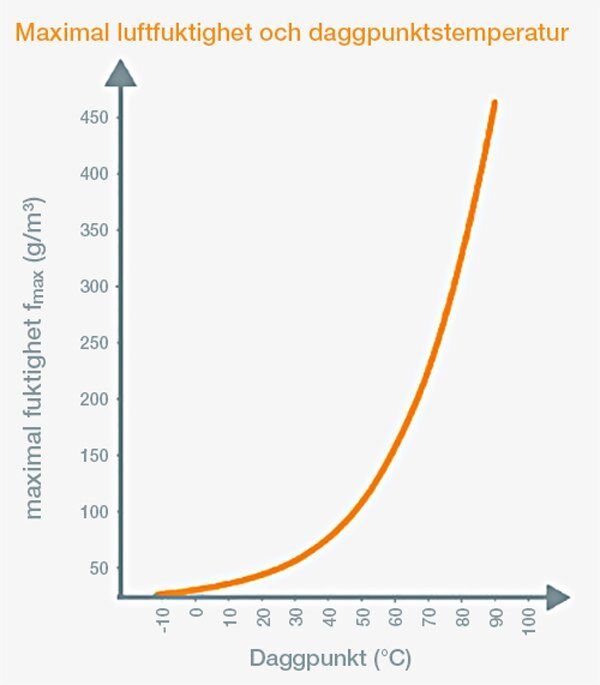FACTS FUKT
Brief moisture facts
Humidity is an important parameter for measuring indoor climate. If the air is too humid, mold can develop. However, indoor climate is not only of great importance in offices and homes. Even in industry, humidity is tested to ensure compliance with product and production quality criteria. Various factors affect the humidity measurement. You can find out what these are and what you need to take into account when using humidity measuring instruments in the factual information below.
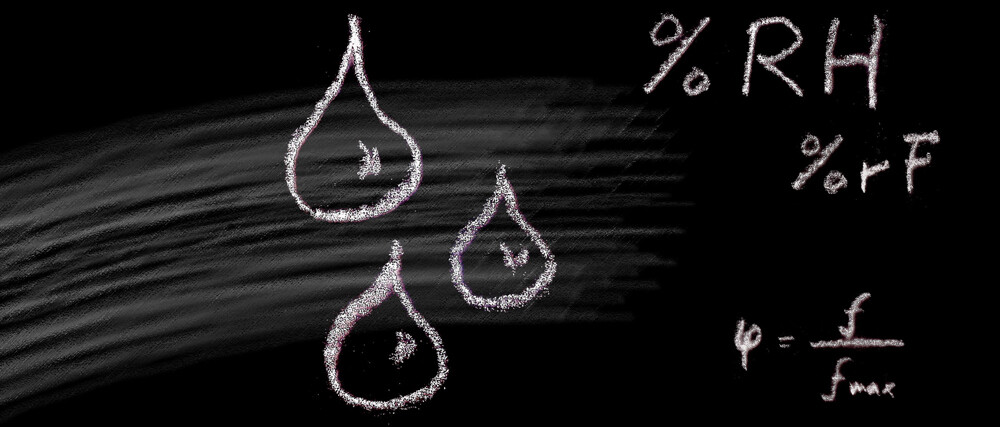
Air humidity
Optimal indoor humidity
Measuring humidity is becoming increasingly important. The adjacent image shows the impact of different humidity levels at normal room temperature. By aiming for an optimal level, many problems can be avoided. For us humans, it is about avoiding ill health. For materials, this may involve avoiding disruptions in manufacturing processes or storing in a climate that provides the best durability.
Humidity levels can fluctuate rapidly. For example, an outdoor temperature drop of 10 °C can reduce indoor humidity by almost 15 %RH. Measurement provides knowledge of the situation and the possibility to influence!
Physical principles of the measurement parameter humidity.
Atmospheric air always contains a certain amount of water vapor. Like all hygroscopic substances, air has a limited ability to absorb water. This limit is called saturation. Below the saturation level, moist air is indistinguishable from dry air to the naked eye. Above the saturation limit, the excess water is visible as fine water droplets (condensation) – a fog forms.
Moisture absorption capacity
The ability of air to absorb moisture depends on the air temperature. The warmer the air is, the more water it can absorb. We can imagine a sponge that changes its absorption capacity depending on the temperature. At 0 °C, the sponge can absorb 4.8 g of water (equivalent to 100% humidity). At more than 4.8 g, the fungus starts to drip. If the fungus has stored 2.4 g of water, this corresponds to 50% relative humidity at 0°C.
At 20 °C, the fungus can store 17.3 g of water (so the fungus has 100% relative humidity at 17.3 g of water). If the fungus has stored 2.4 g of water at 20 °C, this corresponds to approx. 14% relative humidity.
Moisture parameters.
Absolute humidity
The absolute humidity (AH) is calculated by dividing the weight of the water in the air by the volume of the current air mass. The absolute humidity is usually expressed in g/m³.
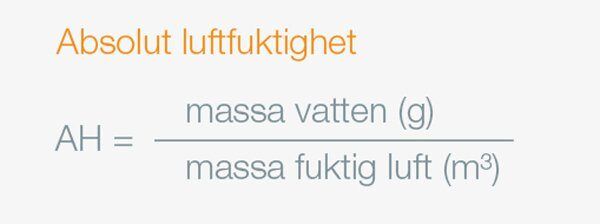
Relative humidity
The relative humidity describes the relationship between the current humidity in the air and the maximum humidity. Relative humidity is given in percent (%RH) or (%RF).
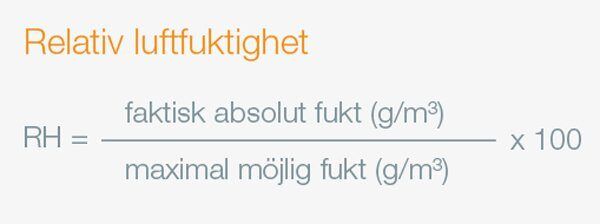
Maximum humidity and dew point temperature
Maximum humidity
Is the maximum possible absolute humidity at a given temperature. It is achieved when the partial pressure of the water vapor in the air is equal to the saturation pressure of the water at the corresponding temperature. In this condition, the relative humidity is 100%.
If the maximum humidity is exceeded, excess water vapor precipitates in the form of condensation (dripping). The saturation humidity is an absolute humidity and is given in g/m³.
Dew point temperature
The dew point temperature is defined as the temperature at which the current water vapor content of the air (100% humidity) is at the maximum possible level. This means that the water vapor pressure is the same as the saturation vapor pressure. The dew point temperature is therefore a parameter that depends on the actual temperature. The dew point temperature can be determined from the ambient temperature and the relative humidity and conversely the relative humidity can be determined from the ambient and dew point temperature. In addition, the absolute humidity of the air can be calculated from the same parameters.
– Measure in the middle of the room.
– Measure at chest height.
– Shield strong radiation sources with your body.
– Hold the sensor at arm’s length and sideways from your body.
– Hold the sensor in your hand and wave it quickly back and forth in the air.
How to avoid measurement errors
Like temperature, humidity is best measured in the middle of a room. In addition, humidity may be recorded in the corners of the room, behind cabinets or similar, which should be noted separately in the report.
Even if you only open the door or are present in the room for a long time, the humidity in the room changes. For this reason, the following applies: Enter the room quickly, close the door and take the measurement immediately.
For humidity sensors, the humidity must first “diffuse” into the plastic layer of the sensor. The duration of the acclimatization time is critically dependent on how well the air circulates around the sensor. It is shortened if the probe is moved in the air.
| A typical situation | What is happening? | The right way to measure |
|---|---|---|
| Influence of temperature | ||
| Instruments and sensors are transported at 0°C ambient temperature during winter. At the measurement site, the measuring equipment enters a room with 20 °C and 50% RH. | Condensation occurs on the humidity sensor: the “microclimate” in the sensor at 0 °C is the maximum saturation of the air. 4.8 g/m³. However, the air in the room contains 9 g/m³ of moisture. | Hold the sensor in your hand and wave it quickly back and forth in the air. It “breaks up” the microclimate (0 °C) in the sensor and the actual room climate of 20 °C and 50% RH reaches the humidity sensor. |
| Your impact | ||
| When measuring, the sensor comes into contact with the user’s breathing. | Breathing on the sensor with moisture-saturated breathing air increases the relative humidity (% RH) of the instrument’s environment and thus the temperature. | Hold the moisturizer at arm’s length from your mouth and wave it around. |
| The right place to measure | ||
| At 25°C, a humidity of 50% relative humidity is measured in the center of the room. | In the same room, at 15°C, the measuring instrument shows a relative humidity of 90% near the wall. Which value is correct? | Like temperature, humidity is best measured in the middle of the room at a height of about 1 meter. If you move the sensor from one climate zone to another without waving it properly in the air, you must allow for an acclimatization time of up to 10 minutes before taking a reading. |
Moisture measuring instruments from Nordtec.
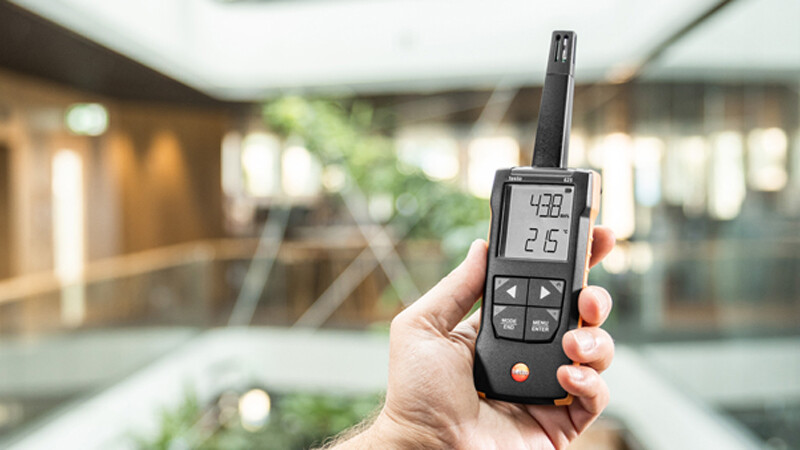
Manual instrument
Testo has a wide range of portable hand instruments for moisture measurement. Ranging from small pocket instruments to more advanced instruments for highly accurate measurements with various calculation functions.
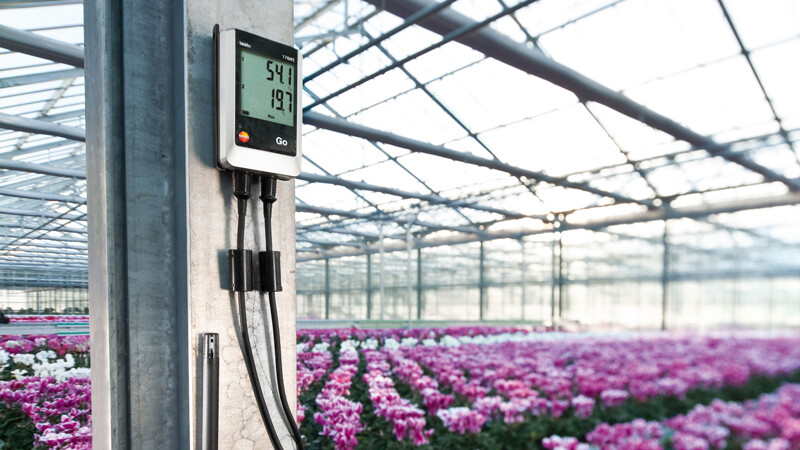
Moisture loggers
Again, there are many different logs to
choose from. From small compact ones to larger multi-channel ones with internal or external sensors. Intuitive software for programming and reading.
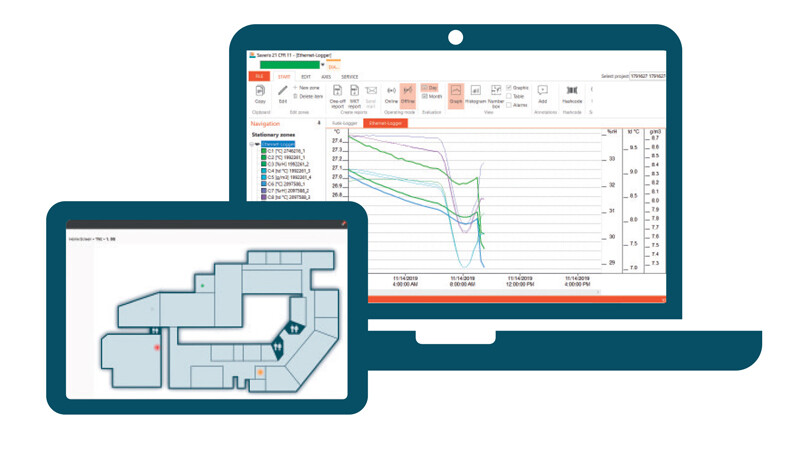
Remote monitoring
We have 4 monitoring systems in our program – all with their special features that are adapted for different applications in e.g.. indoor climate, construction, food, museums, etc.



